How to overcome the barriers to digitising HR
by Silver Cloud

Organisations are still struggling to overcome the barriers to digitising HR.
This is according to a report from cloud HCM provider SAP SuccessFactors which found that the top four barriers are:
- A lack of understanding of what digitising HR means is and who can assist with the transformation (22 per cent)
- Technical debt – not having enough people within the team with digital knowledge (24 per cent)
- A financial infrastructure that does not incentivise individuals to take the steps to create digital businesses (21 per cent), and
- The lack of a risk-taking innovation-driven organisational culture (21 per cent).
All these challenges are completely avoidable however, if tackled head-on at the earliest opportunity.
We take a detailed look at what can be done to overcome the barriers to digitising HR…
Understand what digitising HR means
Digital transformation is everywhere. Yet it is often unclear what digitising HR means. Yes, it involves the transformation of HR processes using social, mobile, analytics and cloud-based technologies. But it’s about so much more.
Digitising HR involves the use of data and analytic tools to identify insights on people that enable faster, more accurate, and more confident business decision making. As SAP SuccessFactors say:
“The ability to manage a mixed workforce that also values freedom of decision, flexibility, and self-service puts the HR departments and the business in a new spectrum of responsibility”
In its guide to building a business case for an HR system, Sage points out several key benefits gained by organisations which have embraced HR digitisation:
- Reduction in employee attrition
- Improved performance
- Reduction in the time to hire
- Better employee experiences
- More reliable data to make informed business decisions
- Ability to accelerate business growth
Decide who can assist with the transformation
In digitising HR, a ‘customer-first approach’ should always be taken – with a heavy focus on collaboration. For businesses that take this approach, it’s common to find multi-department ‘Employee Experience’ teams.
Why? Because, if you get all these departments on board, you’ll have much less resistance to change. With joint ownership, they’ll likely agree on the main objectives and be committed to sharing information.
Depending on the size of your business, you’ll want to make sure the following people are involved:
- Tech experts – the IT Director or Chief Information Officer
- Financial decision-makers – Your Finance Director, Chief Financial Officer and possibly Head of Procurement
- Compliance – with a responsibility to handle data securely, your legal, risk and compliance departments can help mitigate risk and ensure data protection
- Senior decision-makers – your CEO or Managing Director who’ll want to know how digitising HR can foster a more agile and competitive workforce
- Those who will be using the tech – engage with employees and end-users (more on this further down in the article)
Make sure your chosen technology works as a collective
How successful you are at digitising HR depends less on having the most advanced technologies and more on having the right operating systems in place.
Too often, a CEO hears about something their competitors are doing to digitise their workforce and is keen to replicate it. But digitising certain HR processes as a reactive response is rarely a good idea. It can lead to the implementation of (expensive) technology that doesn’t meet the needs of the business. Needless to say, it can also create barriers to further digital projects.
What you want to achieve might not be possible with one technology. Rather than introducing software as and when problems arise, organisations must take a structured approach to digitising HR that enables technologies to work collaboratively.
Take Robotics Process Automation (RPA), for example. It greatly enhances the efficiency of HR processes, but it’s unlikely to give you the same level of insight that specialist HR analytics software will.
We are seeing the emergence of more SaaS solutions. AI technologies that have their foundation in Machine Learning and Natural Language Processing can be packaged with other technologies to significantly improve the employee experience and productivity.
This raises an important question, however. Do you have the technical knowledge within your team to identify the compatibility of technologies and the cost savings that can be made?
Address technical debt
There’s still a tendency to see digitising HR as belonging solely to HR. But the right technology can have a huge transformative effect on a business; one that extends far beyond human resources.
The key is to make sure you have the right people in place to deliver the project.
It’s widely accepted by HR practitioners that it’s important for skills to be considered before, during and post implementation, with 85% of respondents to a Capita Resourcing survey in agreement. Yet 36% of HR managers still find it difficult to identify the exact skills their organisation needs to deliver transformation.
We’ve touched on HR technical debt within a previous blog, but what skills do you need to make sure you digitise HR successfully?
The first thing to remember is that there is big difference between being digitally literate and having the skills to lead a digital transformation.
It’s not enough for HR teams to know how to use people analytics tools and technology. They must also understand why a platform or piece of software should be used, and crucially, when it should not. Knowing how it can be modified for different audiences, and how it will deliver a ROI, is the simple difference between digital skills, and digital literacy.
Quite often, this means bringing in experts, either from within your organisation or in the form of HRIS consultancy support.
A business analyst or statistician can make people data relevant. After all, algorithms only work when there is a defined outcome, e.g. identifying top performers based on a set of metrics.
Such quantifiable data is easily trackable, but for qualitative answers, it’s more complicated. HR teams need to be resolute on what they want their data to do. Will it be proactively used to make business changes or is it just needed to provide an overview? Once established, it’s much easier to know exactly who else in the organisation needs to be involved.
Tackle resistance to change
Digitising the workplace requires a deeply embedded culture shift.
From our experiences of working in HR, we all know that employees can become very comfortable within their roles. The current HR processes are familiar. Change, on the other hand, means learning new processes, and for some, developing new digital skills.
Before starting your transformational HR journey, establish clearly defined goals that make sound business sense. Most of the time, these goals will resolve nagging employee issues.
That’s why the focus should always be on the end-user. Firstly, to leverage technology that people will want to use, and secondly, to devise a communications plan that will encourage them to see the benefits of digitising HR.
- How does it make working life easier?
- What opportunities will it give them?
- How does it fit in with the bigger picture?
You would have answered these questions during the project initiation phase. All you need to do is reformat the key messages in a way that’s easy for employees to engage with.
On a final note
HR can play a significant role in identifying ways an organisation can improve. People analytics empowers business teams to leverage granular data from across their organisations to support pro-active decision making.
Provided that the above barriers are addressed, business productivity can reach unprecedented levels in an incredibly short span of time.
When the right technology is in place and people embrace it, the workplace becomes a whole new world.



